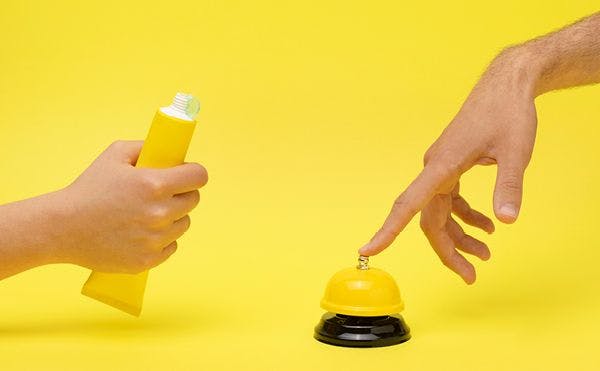Sexual Health 101: Premature Ejaculation
Sexual Health 101: Premature Ejaculation
Symptoms, Causes & Treatments
Symptoms, Causes & Treatments
This month's Sexual Health 101 covers everything you need to know about Premature Ejaculation. Written by Avril Louise Clarke, Clinical Sexologist and Project Manager of my non-profit The Porn Conversation.
The majority of my clients contact me out of frustration due to failed attempts at managing premature ejaculation (PE) and with the eagerness to find solutions to change their sex lives for the better. PE is the most common ejaculation issue that not only causes sexual dissatisfaction for people with penises and their partners, but can be the focal point of relationship issues that often lead to separation.
Whether you are someone experiencing PE or spend any time in close intimate proximity to someone who is, this post is for you. There is so much false information and assumptions about PE that many of my clients feel completely helpless by the time they reach out to me.
As Dr. Jen Gunter states in her book The Vagina Bible,“Power and health are inseparably linked. You can’t be an empowered patient and get the health outcomes you want with inaccurate information and half-truths”. So, let’s clear these so-called “half-truths” up by defining what premature ejaculation is, what are the possible causes, and what we can do to control it.
What is premature ejaculation?
Premature ejaculation is when a penis owner finds that the majority, if not all, of their sexual experiences are ending in dissatisfaction due to involuntary ejaculation following minimal stimulation. To put it simply, they are cumming too quickly. In order to answer the question “how quick is too quick?”, it’s important to grasp the basics of the male sexual response cycle and ejaculation in general.
The Male Sexual Response Cycle
The Male Sexual Response Cycle is the sequence of physical and emotional changes that occur during sex. Over the years, the human sexual response cycles, both male and female, have been criticised as it assumes the uniform pattern of sexual response based on gender. Of course, it’s critical to acknowledge and normalise variability in these cycles, which aren’t always reflective of everyone’s experience regardless of gender. I like to think of the sexual response cycle as a loose association to healthy relational and sexual outcomes.
The male sexual response cycle is made up of four phases: desire (libido), arousal (excitement), orgasm, and resolution. The male sexual response cycle also includes the refractory period, which is the period of time a male needs to recover after the orgasm when a person with a penis is physiologically unable to achieve another orgasm. The length of time a person spends in each phase, the order the phases occur, and the intensity and completion of them varies from person to person and can change with age. The area of the sexual response cycle that is most concerned with premature ejaculation is the third phase, the orgasm. However, the arousal phase is where most of the work can be done to slow things down to avoid another premature response.
The Facts of Ejaculation
According to a study published by The Journal of Sexual Medicine of over five hundred couples from 5 countries, the average person with a penis ejaculates within 5 and a half minutes. Perhaps due to the lack of comprehensive sex education in schools or the unrealistic sexual expectations influenced from online pornography, there are a lot of unrealistic sexual expectations we put on ourselves and our partners. This frustration leads many people who have a penis to believe that they may have premature ejaculation, when they may in fact be experiencing normal sexual responses. Of course, the duration of sex one finds to be pleasurable varies, and there are techniques that can be used to lengthen the time between desire up until ejaculation.
What causes PE?
Although the exact causes of PE are not known, there are many physical, emotional and psychological reasons why a person with a penis may be experiencing it. However, an important part of approaching the treatment of a client with PE is accessing whether it is considered acquired or lifelong.
Acquired premature ejaculation
Acquired PE is when a penis owner is experiencing PE following sexual experiences without ejaculatory problems. There are a number of physical and psychological causes for situational PE which include:
Physical - prostate problems, thyroid problems, and/or substance abuse. In these cases, it is best to seek medical advice from a doctor.
Psychological - depression, stress, relationship issues, and/or performance anxiety.
Lifelong premature ejaculation
Lifelong PE is less common, but is defined when a person with a penis has always experienced premature ejaculation since becoming sexually active. A number of possible causes for this are:
Conditioning - early sexual experiences that are influencing current sexual behaviour. For example, if a young person felt shame or embarrassment when aroused and would masturbate quickly to not get caught, they could have developed a habit that has now caused PE in their adult life.
Trauma - a person who has traumatic sexual experiences in their lifetime can affect their sexual response. Trauma can range from having been shamed for masturbating to being sexually abused.
Upbringing - a male who was brought up in a sex-negative environment may still subconsciously or consciously be affected by the messages they received about sex.
Biological - some penises are ultra sensitive and may find that it difficult to add time between the phase of desire to orgasm.
Can it be controlled?
Fortunately, living with PE doesn’t always mean it’s a lifelong issue. There are methods and support out there that have aided individuals and couples to defeat or learn to manage PE. Changes in behaviour and attitudes can lead to greater and longer-lasting sexual experiences. The following methods are just a handful of techniques that can be used:
Outercourse
Many people define sex as penetration, either anally, vaginally or orally. Many believe that sex is not defined until the moment of penetration. Yet for those living with PE, going straight to penetrative play will often lead to yet another early finish, so prioritising outercourse can be helpful. Outercourse is defined as anything but penetration during sex, which may include kissing, massages, cuddling, and mutual masturbation. Many find outercourse to be a successful approach to redefining sex by adding more items to the menu and leaving penetration off completely. The prioritisation of male ejaculation as the final stage of sex is also important to reconsider. Reorgansing the patterns and pace of our behaviour during sex often leads to a more pleasurable and longer lasting sexual experience.
Stop-Start Method
Popularly known as “edging”, in this method the penis is stimulated during sex or masturbation up until just before the point of ejaculation. When the receiver is about to climax, you or your partner stops until the urge to climax goes away. As the receiver regains control, the penis can be stimulated again. It is recommended that this process is repeated three times and then ejaculation occurs on the fourth round. This method can be repeated both in partnered sex and during masturbation to regain the control of ejaculation.
Squeeze Technique
In this method, the penis is stimulated up until close to ejaculation. When the point of ejaculation is near, the penis is squeezed so the erection partly goes away. The goal of this method is not to cause harm to the owner of the penis, but to become aware of the sensations leading up to ejaculation and can help delay the timing of ejaculation in future sexual experiences.
Sex Therapy
When couples or individuals feel as if they are in need of some additional support, sex therapy with a clinical sexologist can be a great way to conquer or manage PE. The goal of sex therapy is to learn the source of ejaculation issues and seek solutions that is specifically tailored to the client. When therapy is approached as a couple, partners work as a team to learn methods to improve communication and techniques to grow closer both sexually and emotionally in order to manage sexual dysfunction.
Taking care of your sexual health may sometimes mean opening up about issues that are not always easy to talk about. Although it might feel like you are alone, sexual dysfunctions are extremely common and they are nothing to be embarrassed about. When PE is getting in the way of you or your partner’s sexual pleasure, it is time to seek solutions. Every body is deserving of pleasure. Your best sex life might be just around the corner.
Sources used:
American Urological Association
Cleveland Clinic
NHS
The Vagina Bible by Jen Gunter, MD
The Sexual Health 101 column provides information about sexual health related subjects but is not intended to be a substitute for medical or healthcare advice, diagnosis or treatment. Any reader or person with a medical concern should consult with an appropriate doctor or physician.

GET A FREE MOVIE
Want more?
Get a free movie.
Subscribe to our newsletter to get
a free film by Erika Lust & receive
exclusive updates from Lust Zine.


















